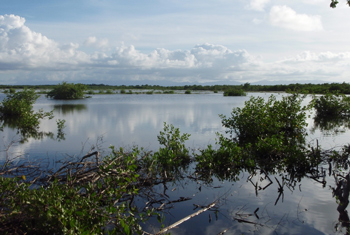Machi and Goshen’s legacy: Increased shorebird-hunting regulations
A group of whimbrels garnered international acclaim in 2011 as they managed to negotiate the winds of Hurricane Irene on their fall migration flight. The joy turned tragic as two of the extreme-flying shorebirds were gunned down shortly after their arrival on the Caribbean island of Guadeloupe.
The deaths of Machi and Goshen sparked an international outcry among conservationists, which led to the recent adoption of legislative and voluntary measures to protect the migratory shorebird population.
The Center for Conservation Biology (CCB) netted Machi and Goshen in August 2009 in an effort to study the whimbrel migration patterns between their arctic breeding grounds and tropical wintering areas. The birds were fitted with solar-powered satellite tracking devices and subsequently released.
Bryan Watts, director of the CCB and a professor of biology at William & Mary, says that tracked birds contributed a great deal to what is known about whimbrel migration along the western Atlantic within the scientific and conservation communities.
 The well-publicized loss of Machi and Goshen heightened awareness of shorebird hunting within the conservation community, leading to a public demand for change in the Caribbean islands where shorebird hunting is legal and traditionally practiced in areas known as “shooting swamps.” Changes have come from the government as well as the hunting community itself and will help to protect whimbrels and other migratory shorebird species.
The well-publicized loss of Machi and Goshen heightened awareness of shorebird hunting within the conservation community, leading to a public demand for change in the Caribbean islands where shorebird hunting is legal and traditionally practiced in areas known as “shooting swamps.” Changes have come from the government as well as the hunting community itself and will help to protect whimbrels and other migratory shorebird species.
Watts pointed out that the Ministry for the Environment, a department within the French federal government, implemented several changes in regulation for the French-governed Caribbean islands of Guadeloupe and Martinique.
These regulation changes include the addition of the red knot and the solitary sandpiper to the species that are protected by the no-hunt list, a bag limit of twenty birds per day and a three-year moratorium on the shooting of Hudsonian godwits and whimbrels.
The hunting community on Barbados, a sovereign island and popular Caribbean destination for migratory shorebirds, joined France in moving to enact positive policy changes. The Barbados Wildfowlers Association has passed a series of self-imposed regulations on the island:
• Limiting the total annual harvest on the island to 22,500 birds
• Limiting the annual harvest to 2,500 birds per swamp
• Limiting the daily harvest to 300 birds per swamp
• Limited the annual harvest of lesser yellowlegs to 1,250 birds per swamp
• Limiting the harvest of American golden plovers to 100 birds per day per swamp
• Limiting the number of active hunters to three per swamp.
Prior to the voluntary adoption of these hunting regulations, the association had previously imposed a moratorium on hunting whimbrel.
“Machi and Goshen have proven to be a catalyst for change,” says Watts “There has been an enormous coming together of the conservation community, government agencies, and other responsible hunting group to work toward sustaining these vulnerable shorebird populations.
In July, Watts gave a keynote address at a meeting of the Society for the Conservation and Study of Caribbean Birds. His talk, “ Tracking whimbrel: Moving toward full life-cycle conservation,” discussed the importance of the West Indies as a shorebird migration corridor and why hunting may be responsible for some of the population declines in shorebirds.
Watts goes on to credit a newborn international working group, formed after what he calls “watershed event in shorebird conservation,” to begin assessing the impact of hunting shorebirds using the Atlantic Flyway.
The international team includes the U.S. Fish and Wildlife Service, the Canadian Wildlife Service, Birdlife International, the Society for the Study and Conservation of Caribbean Birds, AMAZONIA, New Jersey Audubon, and the CCB.
The Center for Conservation Biology is a joint program of William & Mary and Virginia Commonwealth University.
 Skip to main content
Skip to main content

